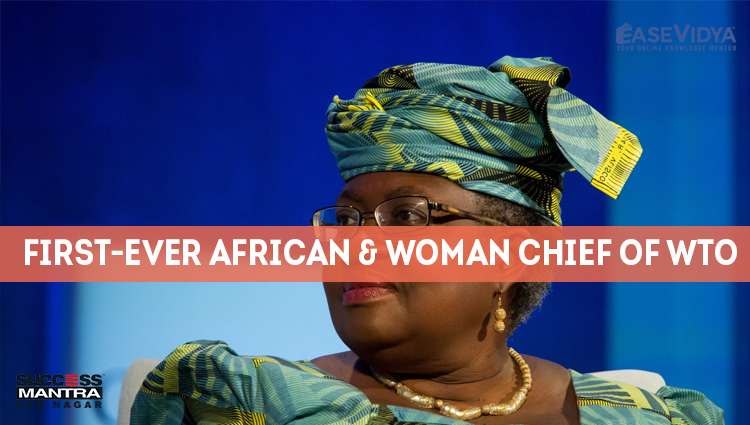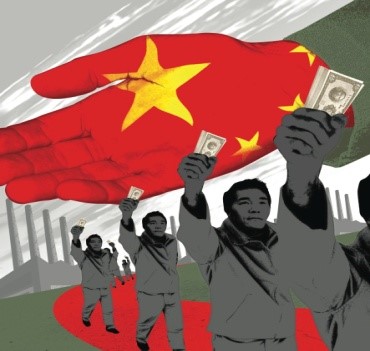
FIRST EVER AFRICAN AND WOMAN CHIEF OF WTO
FIRST-EVER AFRICAN & WOMAN CHIEF OF WTO

Nigeria's Ngozi Okonjo-Iweala was appointed as Director-General of the World Trade Organisation (WTO), the leading international trade body. Ngozi Okonjo-Iweala is the first African official and the first woman to hold the position.
ORIGIN OF WORLD TRADE ORGANISATION
The WTO is the successor to the General Agreement on Tariffs and Trade (GATT), which was created in 1947. The Uruguay Round (1986-94) of the GATT led to the WTO's creation. WTO began operations on 1st January, 1995. The Agreement Establishing the WTO, commonly known as the “Marrakesh Agreement”, was signed in Marrakesh, Morocco in 1994. WTO is an international organization dealing with the rules of trade between nations. Main difference between GATT and WTO was that GATT mostly dealt with trade in goods, the WTO and its agreements could not only cover goods but also trade in services and other intellectual properties like trade creations, designs, and inventions. It has its Headquarters in Geneva, Switzerland.
Members: The WTO has 164 members (including European Union) and 23 observer governments (like Iran, Iraq, Bhutan, Libya etc). India is a founder member of the 1947 GATT and its successor, the WTO.
GOVERNING STRUCTURE OF WTO
Ministerial Conference: of the WTO is dominated by its highest authority, the Ministerial Conference, composed of representatives of all WTO members, which is required to meet at least every two years and which can take decisions on all matters under any of the multilateral trade agreements.
General Council: It is composed of all WTO members and is required to report to the Ministerial Conference. General Council convenes in two particular forms: Dispute Settlement Body: To oversee the dispute settlement procedures. Trade Policy Review Body: To conduct regular reviews of the trade policies of individual WTO members.
OBJECTIVES/AIMS AND ACHIEVEMENTS OF WTO

- To set and enforce rules for international trade. To provide a forum for negotiating and monitoring further trade liberalization. To resolve trade disputes. To increase the transparency of decision-making processes. To cooperate with other major international economic institutions involved in global economic management. To help developing countries benefit fully from the global trading system.
- Global Facilitation of Trade: By building binding rules for global trade in goods and services, WTO has facilitated dramatic growth in cross-border business activity. The WTO has not only enhanced the value and quantity of trade but has also helped in eradicating trade and non-trade barriers.
- Improved Economic Growth: Since 1995, the value of world trade has nearly quadrupled, while the real volume of world trade has expanded by 2.7 times. Domestic reforms and market-opening commitments have resulted in the lasting boost to national income of nations.
- Increased Global Value Chains: The predictable market conditions fostered by the WTO, have combined with improved communications to enable the rise of global value chains, trade within these value chains today accounts for almost 70% of total merchandise trade.
- Upliftment of Poor Countries: The least-developed countries receive extra attention in the WTO. All the WTO agreements recognize that they must benefit from the greatest possible flexibility, and better-off members must make extra efforts to lower import barriers on least-developed countries’ exports.
RECENT CHALLENGES ASSOCIATED WITH WTO

- China’s State Capitalism: China’s state-owned enterprises present a major challenge to the free-market global trading system and the rulebook of the WTO is inadequate for addressing these challenges. It is due to this that USA-China are also engaged in Trade war.
- Institutional Issues: The Appellate Body’s operations have effectively been suspended since December 2019, as the USA’s blocking of appointments has left the body without a quorum of adjudicators needed to hear appeals. The crisis with the dispute settlement function of the WTO is closely linked to the breakdown in its negotiation function.
- Lack of Transparency: There is a problem in WTO negotiations as there is no agreed definition of what constitutes a developed or developing country at the WTO. Members can currently self-designate as developing countries to receive ‘special and differential treatment’ – a practice that is the subject of much contention.
- E-commerce & Digital Trade: While the global trade landscape has changed significantly over the past 25 years, WTO rules have not kept pace. In 1998, realizing that e-commerce would play a growing role in the global economy, WTO members established a WTO e-commerce moratorium to examine all trade-related issues relating to global electronic commerce. Recently, however, the moratorium has been called into question by developing countries because of its implications for collecting revenue.
- Agriculture and Development: Agreement on agriculture is facing issues due to food security and development requirements for developing countries like India.
CONCLUSION
Modernizing the WTO will necessitate the development of a new set of rules for dealing with digital trade and e-commerce. WTO members will also have to deal more effectively with China’s trade policies and practices, including how to better handle state-owned enterprises and industrial subsidies. Given the pressing issues around climate change, increased efforts to align trade and environmental sustainability could help to both tackle climate change and reinvigorate the WTO.
QUESTIONS (1-5)
Q.1 Which of the following was appointed as the first woman Director-General of the World Trade Organisation?
- Ngozi Okonjo-Iweala: ANSWER
- Yoo Myung-hee
- Amina Mohamed
- Audrey Azoulay
Q.2 Consider the following statements and state which of the following is correct regarding the above-mentioned passage?
- WTO is the successor to the General Agreement on Tariffs and Trade (GATT), which was created in 1945.
- Newly appointed, first woman Director-General of the World Trade Organisation hails from Kenya.
- WTO also covers trade in services and other intellectual properties like trade creations, designs, and inventions which is not covered by GATT: ANSWER
- None of the above
Q.3 Which of the following agreements led to the establishment of the WTO as the successor to the General Agreement on Tariffs and Trade (GATT)?
- Marrakesh, Morocco: ANSWER
- Tunis, Tunisia
- Tripoli, Libya
- Abuja, Nigeria
Q.4 Which of the following is not included among the objective of the WTO?
- To improve the standard of living of peoples of the member countries
- To enlarge production and trade of goods
- To protect environment
- To improve the Balance of Payment situation of the member countries: ANSWER
Q.5 Consider the following statements.
- General Council is composed of most developed members and is required to report to the Ministerial Conference.
- In 1998 WTO members established a WTO e-commerce moratorium to examine all trade-related issues relating to global electronic commerce.
Which of the following is correct in the context of the above passage?
- I is correct
- II is correct: ANSWER
- Both I & II is correct
- None is correct












0 Comment